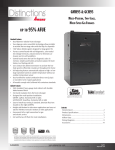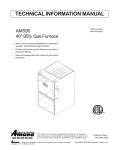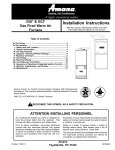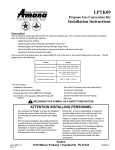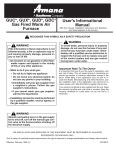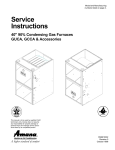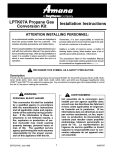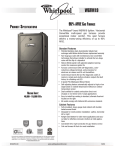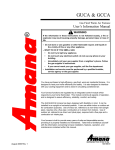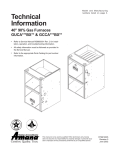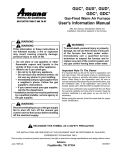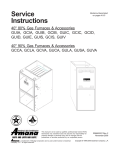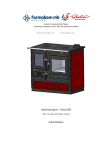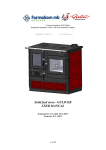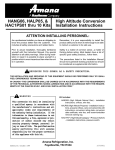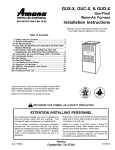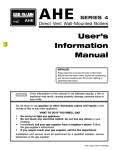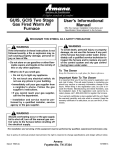Download HANG11-12 HALP10 HAPS27 IO MANUAL
Transcript
® Heating ¡ Air Conditioning A higher standard of comfort HANG11&12, HALP10 and HAPS27 Kits WARNING This conversion kit must be installed by a qualified agency in accordance with the manufacturer’s instructions and all applicable codes and requirements of the authority having jurisdiction. If the information in these instructions is not followed exactly, a fire, explosion or production of carbon monoxide may result causing property damage, personal injury or loss of life. The qualified service agency performing this work assumes responsibility for the proper conversion of this appliance with this kit. High Altitude Conversion Installation Instructions KIT CONTENTS: HANG11/12 (High Altitude Natural Gas) - Installation instructions, natural gas orifices, wire ties. HALP10 (High Altitude Propane Gas) - Installation instructions, propane orifices, gas valve conversion kits with instructions, conversion rating plate, conversion date certificate, wire ties, and screen/turbulator removal warning tag. HAPS27 (High Altitude Pressure Switch) - Installation instructions, pressure switch. IMPORTANT NOTE: These kits are approved for use on Amana furnace models listed on the following page only. These models are part of the family of 40 inch tall, 90 percent, condensing furnaces. THE INSTALLATION AND SERVICING OF THIS EQUIPMENT SHOULD BE PERFORMED ONLY BY QUALIFIED, EXPERIENCED TECHNICIANS. THIS KIT IS NOT INTENDED FOR USE IN CANADA. THE AMANA 90% FURNACES ARE CGA CERTIFIED TO 4500 FEET ONLY. ! RECOGNIZE THIS SYMBOL AS A SAFETY PRECAUTION. ATTENTION INSTALLING PERSONNEL: As a professional installer you have an obligation to know the product better than the customer. This includes all safety precautions and related items. Remember, it is your responsibility to install the product safely and to know it well enough to be able to instruct a customer in its safe use. Prior to actual installation, thoroughly familiarize yourself with this Instruction Manual. Pay special attention to all safety warnings. Often during installation or repair it is possible to place yourself in a position which is more hazardous than when the unit is in operation. Safety is a matter of common sense...a matter of thinking before acting. Most dealers have a list of specific good safety practices...follow them. January 1999 Rev. 1 The precautions listed in this Installation Manual should not supersede existing practices but should be considered as supplemental information. Amana Fayetteville, TN 37334 10314615 II. HANG11 &12, HALP10 Orifice Installation I. Description These kits are required when installing Amana Air Command 90 SSE furnaces above their maximum (as shipped) rated altitudes (Table 1). Above rated altitude, a derating of the appliance must be followed since the CFM moved by the induced draft blower remains almost constant while the pounds of oxygen in that air is reduced as the altitude increases. If this procedure is not followed and the fuel input is not reduced, combustion can be inefficient, incomplete, or possibly result in premature failure of the heat exchanger due to an excessive temperature rise. Furnace Model GUCA GCCA Rated Altitude without Change To avoid the risk of fire, property damage, or personal injury, shut off gas supply first, then disconnect the electrical supply before proceeding with conversion. 1. Remove the Gas Manifold Cut the wire ties securing the wire harness to the manifold. Disconnect low voltage wires from gas valve, and remove the four mounting screws (See Figure 1). Up To 7000 Feet Burner Table 1 Altitude Rating Furnace Model GUCA and GCCA CAUTION Burner Bracket Manifold Altitude Feet Nat. Gas Derate HAPS27 (-0.16" WC) 7001-9000 ft 15.3 ± 4% X 9001-11,000 ft 32.1 ± 4% X Table 2 Pressure Switch Kits The orifices in the high altitude kits have been selected as a result of testing with the American Gas Association. They will provide appropriate derating at altitudes above rated altitudes shown in Table 1. The selection is based on non-derated gas (about 1000 BTU/Ft 3 for natural gas, and 2500 BTU/Ft 3 for propane gas). If your gas supply has been derated for the altitude, contact your gas supplier for orifice sizing. Gas Valve Figure1 Gas Manifold Removal 2. Replace Gas Orifice a. Remove the standard altitude, natural gas orifices (Figure 2 & 3) and replace with orifices from the appropriate kit. Kit usage depends on an installation’s gas usage (natural or propane) and altitude. Refer to Table 3 or 4 for the appropriate kit requirements. Do not derate by adjusting the manifold pressure to a lower pressure setting other than what is specified on the furnace nameplate. A lower air density in combination with a lower manifold pressure at the burner orifice will prohibit the orifice from aspirating the proper amount of air into the burner. This can cause incomplete combustion of the gas, flashback, and/or possible yellow tipping. Orifices In addition to using smaller orifices to reduce the fuel input, a different pressure switch must be used at altitudes above the rated altitudes shown in Table 1. A high altitude pressure switch is required as a result of the reduction in air density. This change is required regardless of the heat content of the fuel used. Figure 2 Replacing Gas Orifices 2 III. HAPS27 Pressure Switch Installation WARNING To avoid death or personal injury due to electrical shock, disconnect the electrical supply to the furnace before installing this kit or performing any service. Figure 3 Orifices Furnace Model GUCA GCCA GUCA GCCA Kit Number Altitude (Feet) Orifice HANG11 7001-9000 #44 HANG12 9001-11,000 #45 1. Shut off gas and disconnect power supply to furnace. 2. Locate the induced draft blower pressure switch. Yellow and Orange Electrical Connections Mounting Bracket Screw NOTE: Units Installed in Canada are certified to 4500 feet only, therefore these kits are not applicable in Canada. Table 3 Natural Gas Orifice Kits* * * * M 1 P 3 O * F F C 2 ON * * * Induced Draft Blower Pressure Switch * This table assumes non-derated natural gas (about 1000 BTU/Ft3). If your gas supply has been derated for the altitude, contact your gas supplier for orifice sizing. Furnace Model GUCA GCCA Kit Number Altitude (Feet) Orifice HALP10 7001-11,000 #56 Induced Draft Blower Pressure Switch Mounting Screws Pressure Switch Hose Induced Draft Blower Figure 4a Induced Draft Blower Pressure Switch Location (GUCA) NOTE: Units Installed in Canada are certified to 4500 feet only, therefore these kits are not applicable in Canada. Induced Draft Blower Pressure Switch Mounting Screws Table 4 Propane Gas Orifice Kits b. Tighten orifices with a box-end wrench. Do not use a socket wrench, as it could damage the orifices. Do not overtighten. Do not cross thread. c. Reinstall the gas manifold to burner bracket assembly using screws removed in step 1. Make certain the orifices are inserted in each burner and that each burner remains properly seated in the burner bracket. d. Connect low voltage gas valve wires to gas valve. Refer to wiring diagram for proper connection. e. Wire tie wiring harness to manifold. Make certain wires do not interfere with gas flow from orifices or through burners, or contact any hot surfaces. Mounting Bracket Screws (Underneath Blower Deck) Induced Draft Blower Induced Draft Blower Pressure Switch Yellow and Orange Electrical Connections Pressure Switch Hose NOTE: If converting to propane gas, see PROPANE GAS CONVERSION section for additional instructions. Figure 4b Induced Draft Blower Pressure Switch Location (GCCA) 3 WARNING CAUTION To avoid personal injury or property damage due to fire, make certain all wires disconnected from the pressure switch during this procedure are properly reconnected. 3. Disconnect the pressure switch hose from the pressure switch. 4. Disconnect the yellow and orange wires from pressure switch. 5. Remove pressure switch. Upflow (GUCA) models (Figure 4a): Remove pressure switch mounting bracket screw securing pressure switch and mounting bracket to partition panel. Counterflow (GCCA) models (Figure 4b): Remove mounting bracket screws securing pressure switch and mounting bracket to blower deck. 6. Remove screws from mounting bracket and transfer the bracket to the HAPS27 pressure switch. Be sure to maintain the same orientation as on the standard altitude switch. 7. Install the HAPS27 pressure switch using screw(s) removed in step 5. 8. Connect the yellow and orange wires to the HAPS 27 pressure switch. 9. Reconnect the pressure switch hose to new switch. 10. Verify proper furnace operation. IV. HALP10 Propane Gas Conversion WARNING PERSONAL INJURY HAZARD If your propane gas furnace is installed in a basement, an excavated area or a confined space, we strongly recommend that you contact your propane supplier about installing a warning device that would alert you to a gas leak. Propane gas is heavier than air and any leaking gas can settle in any low areas or confined spaces. Propane gas odorant may fade, making the gas undetectable except with a warning device. An undetected gas leak would create a danger of explosion or fire. If you suspect the presence of gas, follow the instructions on the cover of the furnace installation manual. Failure to do so could result in SERIOUS PERSONAL INJURY OR DEATH. PERSONAL INJURY HAZARD Iron oxide (rust) can reduce the level of odorant in propane gas. A gas detecting device is the only reliable method to detect a propane gas leak. Contact your propane supplier about installing a gas detecting warning device to alert you in the event that a gas leak should develop. Failure to detect a propane gas leak could result in an EXPLOSION or FIRE which could cause SERIOUS PERSONAL INJURY OR DEATH. CAUTION To prevent unsatisfactory furnace operation, the proper gas conversion kit must be used for each valve. Use the WhiteRodgers spring kit only with the WhiteRodgers gas valve, Honeywell spring kit only with the Honeywell gas valve and Robertshaw spring kit only with the Robertshaw gas valve. THE SPRING KITS ARE NOT INTERCHANGEABLE. IMPORTANT: Propane gas is heavier than air and does not vent upward as with natural gas fuels. 1. Replace the gas valve regulator spring with one of the new springs included in this propane gas conversion kit. • If the unit is equipped with a White-Rodgers 36E gas valve, (Figures 5 & 6), use Spring Kit #92-0659. • If the unit is equipped with a Honeywell VR8205 gas valve, (Figure 7), use Spring Kit #393691. • If the unit is equipped with a Robertshaw 7222 gas valve, (Figure 8), use Spring Kit #54300. In each case, change the regulator spring per instructions included with that particular regulator spring. Discard unused spring kits. 2. Attach the label (found in the spring kit) to the gas valve, indicating propane conversion. 3. Attach conversion data plate, with correct input rating, adjacent to the unit rating plate. 4. Post “conversion date certificate” on or adjacent to the furnace. 4 Gas Valve On/Off Selector Switch O F F INLET M 1 P 3 C 2 Gas Valve On/Off Control Lever In ON Position OUTLET ON INLET Inlet Pressure Tap (Side of Valve) Pressure Regulator Adjustment (Under Cap Screw) OUTLET Outlet (Manifold) Pressure Tap (Side of Valve) Inlet Pressure Tap (Side of Valve) Figure 5 White-Rodgers 36E22 Gas Valve Outlet (Manifold) Pressure Tap (Side of Valve) Pressure Regulator Adjustment (Under Cap Screw) Figure 8 Robertshaw Model 7222 Gas Valve On/Off Control Knob V. Operational Check INLET OUTLET The position of the ignitor, relative to the burner is not affected by these conversion procedures. 1. Visually inspect the ignitor for damage. If there is damage, replace the ignitor. Inlet Pressure Tap (Side of Valve) Pressure Regulator Adjustment (Under Cap Screw) Outlet (Manifold) Pressure Tap WARNING To avoid the risk of fire or explosion, do not use a flame to check for leaks. Figure 6 White-Rodgers Model 36E36 Pressure Regulator Adjustment (Under Cap Screw) Outlet (Manifold) Pressure Tap Honeywell INLET OUTLET ON OFF Inlet Pressure Tap Gas Valve On/Off Control Knob Figure 7 Honeywell VR8205 Gas Valve 2. Leak test the orifice threads using a soap solution. If leaks are found, repair before proceeding with operational check of furnace. 3. Start the furnace using the procedures found in the furnace’s installation instructions section, “Startup Procedures and Adjustments”. 4. Check Gas Supply Pressure The line pressure supplied to the gas valve must be within the range specified below. The supply pressure can be measured at the gas valve inlet pressure tap or at a hose fitting installed in the gas piping drip leg. The supply pressure must be measured with the burners operating. To measure the gas supply pressure, use the following procedure. a. Turn OFF gas to furnace at the manual gas shutoff valve external to the furnace. b. Connect a calibrated water manometer (or appropriate gas pressure gauge) at either the gas valve inlet pressure tap or the gas piping drip leg. NOTE: At either location, a hose fitting must be installed prior to making the hose connection. 5 Manifold Gas Pressure Natural Gas 3.5" w.c. Propane Gas 10.0" w.c. Gas Line Gas Shutoff Valve Gas Line To Furnace Open To Atmosphere Drip Leg Cap With Fitting Manometer Hose Manometer Figure 9 Manometer c. Turn ON the gas supply and operate the furnace and all other gas consuming appliances on the same gas supply line. d. Measure furnace gas supply pressure with burners firing. Supply pressure must be within the range specified in the table below. Natural Gas Propane Gas Inlet Gas Supply Pressure Minimum:5.0" W.C. Maximum :10.0" W.C. Minimum:11.0" W.C. Maximum :13.0" W.C. If supply pressure differs from above, make necessary adjustments to pressure regulator, gas piping size, etc., and/or consult with local gas utility. e. Turn OFF gas to furnace at the manual shutoff valve and disconnect manometer. Reinstall plug before turning on gas to furnace. f. Turn OFF any unnecessary gas appliances started in step c. 5. Check Manifold Pressure Only small variations in gas pressure should be made by adjusting the gas valve pressure regulator. The manifold pressure must be measured with the burners operating. To measure and adjust the manifold pressure, use the following procedure. a. Turn OFF gas to furnace at the manual gas shutoff valve external to the furnace. b. Connect a calibrated water manometer (or appropriate gas pressure gauge) at the gas valve outlet pressure tap (refer to gas valve figure in previous section). c. Turn ON the gas supply and operate the furnace. d. Measure gas manifold pressure with burners firing. Adjust manifold pressure using the following table. The final manifold pressure must not vary more than ± 0.3 “ w.c. from the above specified pressures. Any necessary major changes in gas flow rate should be made by changing the size of the burner orifice. e. To adjust the gas valve pressure regulator, remove the regulator cap. f. Turn the adjustment screw clockwise to increase the pressure, or counterclockwise to decrease the pressure. g. Securely replace the regulator cap. h. Turn OFF gas to furnace at the manual shutoff valve and disconnect manometer. i. Reinstall gas valve outlet pressure tap plug before turning on gas to furnace. 6. Check Gas Input Rate (Natural Gas Only) The gas input rate to the furnace must never be greater than that specified on the unit rating plate. To measure the gas input using the gas meter, proceed as follows: a. Turn OFF the gas supply to all other gas-burning appliances except the furnace. b. While the furnace is operating, time and record one complete revolution of the smallest gas meter dial. c. Calculate the number of seconds per cubic foot (sec/ ft3) of gas being delivered to the furnace. If the dial is a one cubic foot dial, divide the number of seconds recorded in step 2 by one. If the dial is a two cubic foot dial, divide the number of seconds recorded in step 2 by two. d. Calculate the furnace input in BTUs per hour (BTU/ hr). Input equals the sum of the installation’s gas heating value and a conversion factor (hours to seconds) divided by the number of seconds per cubic foot. The measured input must not be greater than the input indicated on the unit rating plate. INPUT CALCULATION EXAMPLE: Installation’s gas heating (HTG) value: 1,000 BTU/ ft3 (Obtained from gas supplier) Installation’s seconds per cubic foot: 34 sec/ ft3 Conversion Factor (hours to seconds): 3600 sec/hr Input = (Htg. value x 3600) ÷ seconds per cubic foot Input = (1,000 BTU/ft3 x 3600 sec/hr) ÷ 34 sec/ ft3 Input = 106,000 BTU/hr This measured input must agree with the derates for your unit and altitude as indicated in Table 2 on page 2. Derating Example 1: GUCA115AX50 at 8000 ft. Sea level input = 115000 BTU/Hr. From Table 1: Derate at 8000 ft. =15.3±4% Since we are at the mid point of the elevation range, we use the mid point of the derate; 15.3%. New Input = 115000 x (1 - .153) = 97,405 BTU/Hr 6 Derating Example 2: GUCA115AX50 at 7001 ft. HEAT EXCHANGER RADIATION "LINE OF SIGHT" Sea level input = 115000 BTU/Hr. From Table 1: Derate at 7001 ft. = 15.3±4% SUPPLY AIR Since we are at the lower end of the elevation range, we use the lower derate: (15.3 - 4) = 11.3% TSUPPLY New Input = 115000 x (1 - .113) = 102,005 BTU/Hr e. Turn ON gas and relight all other appliances turned off in step 6a. Be certain that all appliances are functioning properly and that all pilot burners are operating. 7. Check The Gas Input - Propane Gas Verify the gas input rate by checking that the appropriate orifices have been installed and the manifold pressure has been set as stated in these instructions. 8. Check Burner Flames. With the burner compartment door in place, check burner flames through the view port. Flames should be stable, soft and blue, (dust may cause orange tips but they must not be yellow). They should extend directly outward from the burners without curling, floating, or lifting off. 9. Check the normal operating sequence of the ignition system to insure burners light properly. 10. Check Temperature Rise Temperature rise must be within the range specified on the unit rating plate. An incorrect temperature rise may result in condensing in or overheating of the heat exchanger. An air flow and temperature rise table is provided in the specification sheet. Determine and adjust temperature rise as follows: NOTE: At higher altitudes, the relationship between external static pressure and temperature rise will be different than is shown in the installation instructions, while the relationship between CFM and temperature rise will be approximately the same. Temperature rise must still be within the limits shown on the unit nameplate. a. Operate furnace with burners firing for approximately ten minutes. Ensure all registers are open and all duct dampers are in their final (fully or partially open) position. b. Place thermometers in the return and supply ducts as close to the furnace as possible. Thermometers must not be influenced by radiant heat by being able to “see” the heat exchanger. 7 RISE = TSUPPLY - TRETURN TRETURN RETURN AIR Figure 10 Temperature Rise Measurement c. Subtract the return air temperature from the supply air temperature to determine the air temperature rise. Allow adequate time for thermometer readings to stabilize. d. Adjust temperature rise by adjusting the circulator blower speed. Increase blower speed to reduce temperature rise. Decrease blower speed to increase temperature rise. If it is necessary to adjust the blower speed, consult the furnace installation manual for details. VI. Complete The Installation Refer to the furnace installation manual for all installation details which were not covered in this manual.







